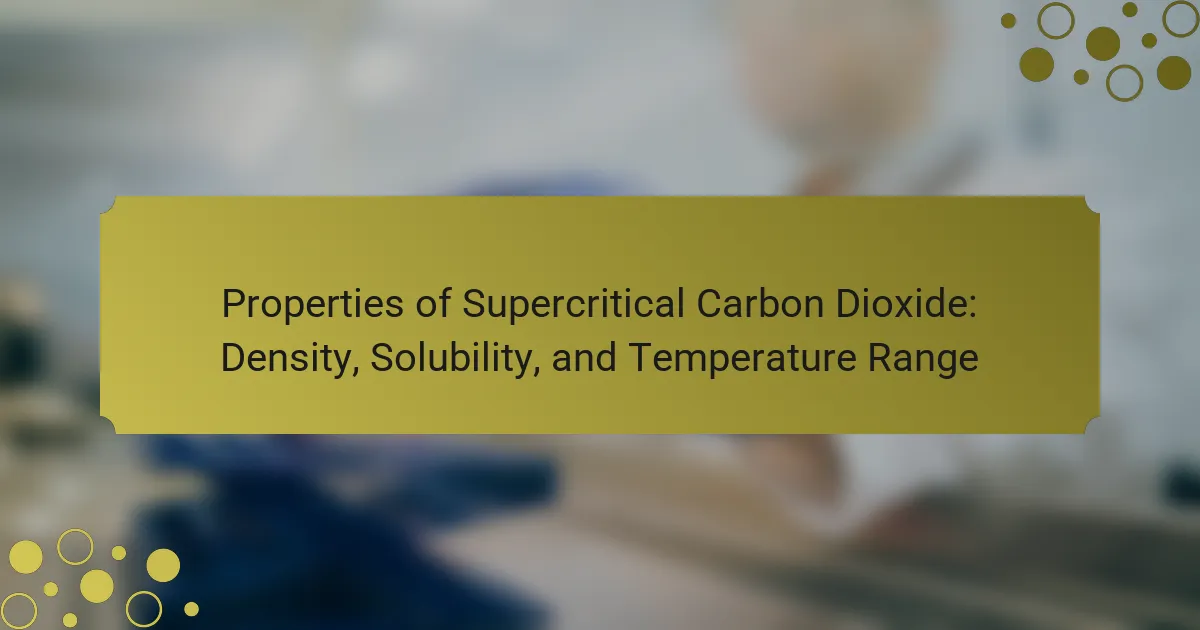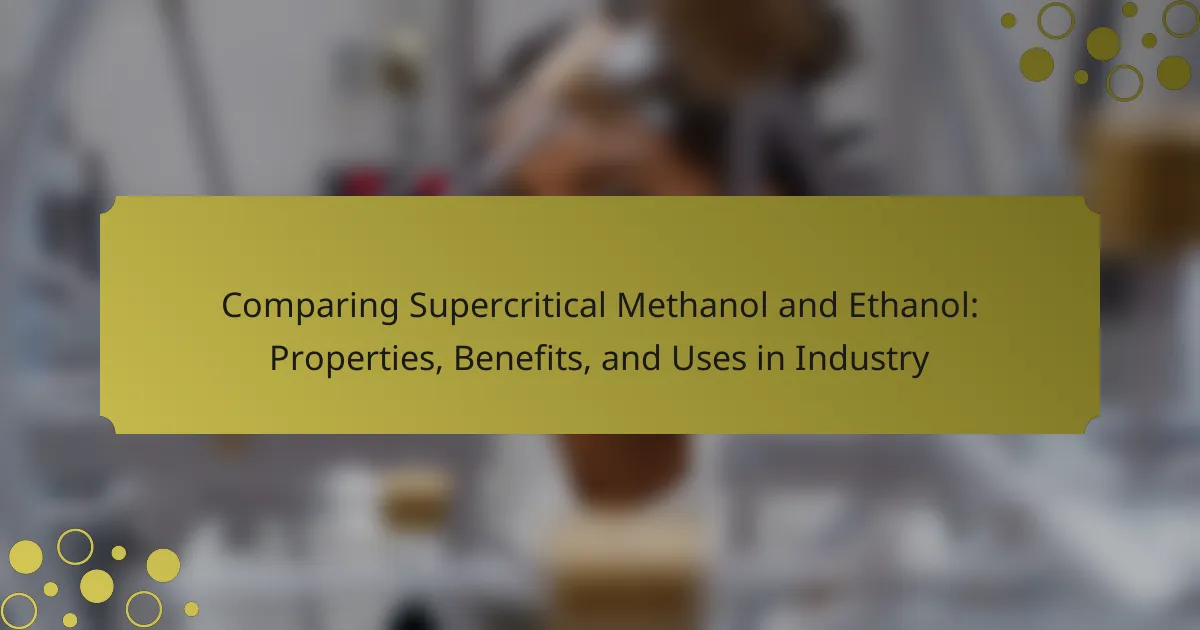Supercritical fluids are substances that exist above their critical temperature and pressure, allowing them to possess properties of both liquids and gases. This article explores the thermal conductivity of supercritical fluids, focusing on measurement techniques such as the transient hot wire method, laser flash analysis, and the guarded hot plate method. It highlights the significance of thermal conductivity in industrial applications, including supercritical fluid extraction, enhanced oil recovery, and energy efficiency in manufacturing and HVAC systems. Understanding these properties is essential for optimizing processes and selecting appropriate materials for specific applications.

What are Supercritical Fluids and Their Thermal Conductivity?
Supercritical fluids are substances that exist above their critical temperature and pressure, allowing them to exhibit properties of both liquids and gases. In this state, they can diffuse through solids like a gas and dissolve materials like a liquid. The thermal conductivity of supercritical fluids varies significantly based on their composition and temperature. For example, carbon dioxide as a supercritical fluid has a thermal conductivity of approximately 0.1 W/m·K at 31°C and 73.8 bar. This property is crucial for applications in extraction processes and chemical reactions. Understanding their thermal conductivity helps optimize industrial processes that utilize supercritical fluids, such as supercritical fluid extraction and enhanced oil recovery.
How do supercritical fluids differ from gases and liquids?
Supercritical fluids differ from gases and liquids in their unique state that combines properties of both. Supercritical fluids exist above their critical temperature and pressure, where distinct liquid and gas phases do not exist. In this state, they exhibit a density similar to liquids but have the viscosity and diffusivity of gases. This allows supercritical fluids to dissolve materials like liquids while being able to penetrate solids like gases. For example, carbon dioxide becomes supercritical at 31.1°C and 73.8 atm, demonstrating its ability to act as a solvent in extraction processes. These unique characteristics enable supercritical fluids to be used in various industrial applications, such as extraction and chromatography.
What physical properties characterize supercritical fluids?
Supercritical fluids are characterized by unique physical properties that emerge at conditions above their critical temperature and pressure. They exhibit properties of both gases and liquids. Supercritical fluids have high density, allowing them to dissolve substances like liquids. They also have low viscosity, which enhances their ability to flow like gases. Additionally, supercritical fluids possess high diffusivity, enabling rapid mass transfer. Their thermal conductivity is typically higher than that of liquids, which is significant for industrial applications. These properties make supercritical fluids effective solvents in processes like extraction and chemical reactions.
Why is thermal conductivity important in supercritical fluids?
Thermal conductivity is crucial in supercritical fluids because it influences heat transfer efficiency. Supercritical fluids exhibit unique thermal properties that differ from their liquid and gas phases. High thermal conductivity enhances the ability to transfer heat in industrial processes. This is particularly important in applications like extraction and chemical reactions. Efficient heat transfer can improve reaction rates and product yields. Studies show that the thermal conductivity of supercritical fluids can significantly affect process design. For example, carbon dioxide in supercritical state has a higher thermal conductivity than in liquid form. This property is essential for optimizing energy use in various applications.
What factors influence the thermal conductivity of supercritical fluids?
The thermal conductivity of supercritical fluids is influenced by several factors. Temperature significantly affects thermal conductivity. As temperature increases, thermal conductivity typically rises due to enhanced molecular motion. Pressure also plays a crucial role; higher pressure can lead to increased density, impacting thermal conductivity. The specific heat capacity of the fluid is another important factor. Fluids with higher specific heat capacities often exhibit higher thermal conductivities. Additionally, the molecular structure of the supercritical fluid affects its thermal properties. Fluids with more complex molecular arrangements may have different thermal conductivities compared to simpler structures. Lastly, the presence of impurities or additives can alter the thermal conductivity of supercritical fluids by affecting their molecular interactions.
How does temperature affect thermal conductivity in supercritical fluids?
Temperature significantly affects thermal conductivity in supercritical fluids. As temperature increases, the thermal conductivity of supercritical fluids generally rises due to enhanced molecular motion. This increased motion allows for more efficient energy transfer between particles. For instance, studies show that the thermal conductivity of supercritical carbon dioxide increases with temperature, with values ranging from 0.1 W/m·K at lower temperatures to about 0.2 W/m·K at elevated temperatures. This behavior is attributed to the reduction in density and changes in molecular interactions as the supercritical fluid transitions from a liquid-like to a gas-like state. Additionally, the specific heat capacity also influences thermal conductivity, as higher temperatures often lead to increased specific heat, further enhancing thermal transfer efficiency.
What role does pressure play in determining thermal conductivity?
Pressure significantly influences thermal conductivity in materials. As pressure increases, the density of the material typically rises. This change in density can enhance the interaction between particles, facilitating better heat transfer. In supercritical fluids, for example, increased pressure leads to more efficient thermal conduction. Studies show that thermal conductivity can increase by up to 20% under high-pressure conditions. This relationship is crucial in industrial applications where precise thermal management is necessary. Understanding this effect helps in optimizing processes involving supercritical fluids.

What Measurement Techniques are Used for Thermal Conductivity?
Common measurement techniques for thermal conductivity include the transient hot wire method, laser flash analysis, and guarded hot plate method. The transient hot wire method measures thermal conductivity by analyzing the temperature response of a wire heated by a pulse of electricity. Laser flash analysis involves a short laser pulse heating a sample, with the resulting temperature rise measured to calculate thermal conductivity. The guarded hot plate method uses a steady-state approach, where a sample is sandwiched between two plates, and heat flow is measured to determine thermal conductivity. These techniques have been validated through extensive research and are widely used in both academic and industrial applications.
What are the common methods for measuring thermal conductivity?
The common methods for measuring thermal conductivity include the steady-state method, transient method, and laser flash analysis. The steady-state method involves maintaining a constant temperature gradient and measuring heat flow. This method is widely used for solids and liquids. The transient method measures temperature changes over time to determine thermal conductivity. It is effective for both solids and fluids. Laser flash analysis uses a short laser pulse to heat a sample and measures the resulting temperature rise. This method is particularly useful for materials with low thermal conductivity. Each method has specific applications and limitations based on the material being tested.
How does the transient hot wire method work for supercritical fluids?
The transient hot wire method measures thermal conductivity in supercritical fluids by using a thin wire as a heat source. This wire is heated and placed in the fluid under study. As the wire heats up, it transfers heat to the surrounding fluid. The temperature change in the wire is monitored over time. This temperature change provides data on the heat transfer rate. The rate of heat transfer is directly related to the thermal conductivity of the fluid. The method is effective for supercritical fluids because it can operate under high pressure and temperature conditions. Studies have shown that this method yields accurate results for thermal conductivity in various supercritical fluids.
What is the significance of the laser flash analysis technique?
The laser flash analysis technique is significant for measuring thermal conductivity. It provides rapid and accurate assessments of materials’ thermal properties. This technique utilizes a short laser pulse to heat a sample. The resulting temperature rise is monitored to determine thermal conductivity. It is particularly useful for supercritical fluids, where traditional methods may be less effective. Studies have shown that laser flash analysis can measure thermal conductivity with high precision in various materials. This capability enhances material characterization in industrial applications.
What challenges are faced in measuring thermal conductivity of supercritical fluids?
Measuring thermal conductivity of supercritical fluids presents several challenges. One major challenge is the lack of standardized measurement techniques. Different methods can yield inconsistent results. Another challenge is the complex phase behavior of supercritical fluids. This behavior affects how heat is transferred within the fluid. Additionally, the high pressures and temperatures involved can complicate measurements. Equipment must be specially designed to withstand these conditions. Variability in fluid composition can also impact thermal conductivity. Accurate measurements require precise control of these variables. Lastly, limited theoretical models make it difficult to predict thermal conductivity accurately. These models often do not account for all influencing factors.
How do high pressures complicate measurement techniques?
High pressures complicate measurement techniques by introducing significant challenges in data accuracy and instrument reliability. Instruments may experience calibration issues under high pressure, leading to erroneous readings. The physical properties of materials can change, affecting sensor performance. High pressures can also cause leaks in measurement systems, compromising data integrity. Additionally, the behavior of supercritical fluids can vary unpredictably under pressure, complicating thermal conductivity measurements. These challenges necessitate specialized equipment and techniques to ensure accurate results in high-pressure environments.
What are the limitations of existing measurement methods?
Existing measurement methods for thermal conductivity of supercritical fluids face significant limitations. These methods often lack precision due to the complex behavior of supercritical fluids. Temperature and pressure variations can lead to inconsistent results. Many methods also require extensive calibration, which is time-consuming and may introduce errors. Furthermore, some techniques are limited by the physical properties of the fluids, affecting their applicability. For instance, methods like transient hot wire may not effectively capture rapid thermal responses. Additionally, the influence of impurities in supercritical fluids can skew measurements. These limitations hinder the reliability of data for industrial applications.

What are the Implications of Thermal Conductivity for Industry?
Thermal conductivity significantly impacts industrial processes and efficiency. It influences heat transfer rates in materials and systems. Higher thermal conductivity materials enhance energy efficiency in heating and cooling applications. This property is crucial in industries such as manufacturing, HVAC, and energy production. For example, materials with high thermal conductivity reduce energy costs in thermal management systems. Conversely, low thermal conductivity materials serve as effective insulators. This characteristic is vital in applications requiring temperature control. Understanding thermal conductivity aids in selecting appropriate materials for specific industrial applications.
How does thermal conductivity impact industrial applications of supercritical fluids?
Thermal conductivity significantly impacts industrial applications of supercritical fluids. It determines the efficiency of heat transfer in processes such as extraction, reaction, and separation. Higher thermal conductivity allows for quicker thermal responses, enhancing process control. This leads to improved energy efficiency in industrial operations. For example, supercritical CO2 is often used in extraction due to its favorable thermal properties. Research shows that supercritical fluids with high thermal conductivity can reduce processing times by up to 30%. This efficiency is crucial in industries like pharmaceuticals, food processing, and materials science. Thus, optimizing thermal conductivity is essential for maximizing the performance of supercritical fluid applications.
What industries benefit from enhanced thermal conductivity of supercritical fluids?
The industries that benefit from enhanced thermal conductivity of supercritical fluids include energy, chemical processing, and pharmaceuticals. In the energy sector, supercritical fluids improve heat transfer in power generation systems. This leads to increased efficiency in processes like supercritical steam cycles. In chemical processing, enhanced thermal conductivity aids in heat exchange during reactions. This results in faster reaction times and improved yields. In pharmaceuticals, supercritical fluids are used in extraction and formulation processes. Enhanced thermal conductivity allows for better control of temperature, improving product quality. These industries leverage the unique properties of supercritical fluids to optimize their processes and outcomes.
How can improved thermal conductivity lead to energy efficiency?
Improved thermal conductivity enhances energy efficiency by enabling faster heat transfer. Efficient heat transfer reduces energy loss in systems like heating and cooling. For example, materials with high thermal conductivity require less energy to maintain desired temperatures. This results in lower operational costs and reduced energy consumption. Studies show that optimizing thermal conductivity in industrial processes can lead to significant energy savings. Enhanced thermal management in supercritical fluids can also improve system performance. Therefore, improved thermal conductivity directly contributes to overall energy efficiency in various applications.
What are the future trends in the study of thermal conductivity in supercritical fluids?
Future trends in the study of thermal conductivity in supercritical fluids include the development of advanced measurement techniques. Researchers are focusing on improving precision in thermal conductivity measurements. Enhanced computational models are also being utilized to predict thermal behavior in supercritical states. The integration of machine learning algorithms is expected to optimize data analysis and interpretation. Additionally, there is a growing interest in the application of supercritical fluids in energy systems. Studies are increasingly examining their role in heat transfer applications. The exploration of novel supercritical fluid mixtures is anticipated to yield new insights into thermal properties. Overall, these trends aim to enhance the practical applications of supercritical fluids in various industries.
How might advancements in technology improve measurement techniques?
Advancements in technology can significantly improve measurement techniques by enhancing precision and efficiency. New sensors and instruments allow for more accurate data collection. For example, digital thermometers provide real-time temperature readings with minimal error. Innovations in data processing enable faster analysis of measurement data. Automated systems reduce human error in data collection and interpretation. Advanced imaging techniques, such as infrared thermography, improve the visualization of thermal conductivity. These improvements lead to better understanding of supercritical fluids. Enhanced measurement techniques can directly impact industrial applications, ensuring optimal performance and safety.
What role will supercritical fluids play in future industrial processes?
Supercritical fluids will play a significant role in future industrial processes by enhancing extraction and separation techniques. Their unique properties allow for efficient solvation and mass transfer. This leads to reduced energy consumption compared to traditional solvents. Industries such as pharmaceuticals and food processing will benefit from cleaner and greener processes. Supercritical carbon dioxide is already used for caffeine extraction in coffee. Research shows that supercritical fluids can improve reaction rates in chemical synthesis. This can lead to higher yields and lower waste production. Overall, supercritical fluids are poised to revolutionize various industrial applications through their versatility and efficiency.
What best practices should industries follow regarding thermal conductivity of supercritical fluids?
Industries should prioritize accurate measurement techniques for the thermal conductivity of supercritical fluids. Utilizing high-precision instruments ensures reliable data. Regular calibration of these instruments is essential for maintaining accuracy. Employing standardized testing protocols enhances comparability of results. Maintaining controlled environmental conditions minimizes variability in measurements. Conducting repeated trials helps to confirm consistency in data. Collaborating with research institutions can provide access to advanced methodologies. Lastly, documenting all findings thoroughly supports ongoing improvements and compliance with industry standards.
The main entity of this article is supercritical fluids, which are substances that exist above their critical temperature and pressure, exhibiting unique properties of both liquids and gases. The article provides a comprehensive overview of the thermal conductivity of supercritical fluids, detailing how it varies with composition, temperature, and pressure, and its importance in industrial applications such as extraction and chemical reactions. It discusses various measurement techniques for thermal conductivity, including the transient hot wire method and laser flash analysis, while addressing the challenges faced in obtaining accurate measurements. Additionally, the implications of thermal conductivity for energy efficiency and industrial processes are explored, highlighting the potential future trends and best practices for industries utilizing supercritical fluids.



